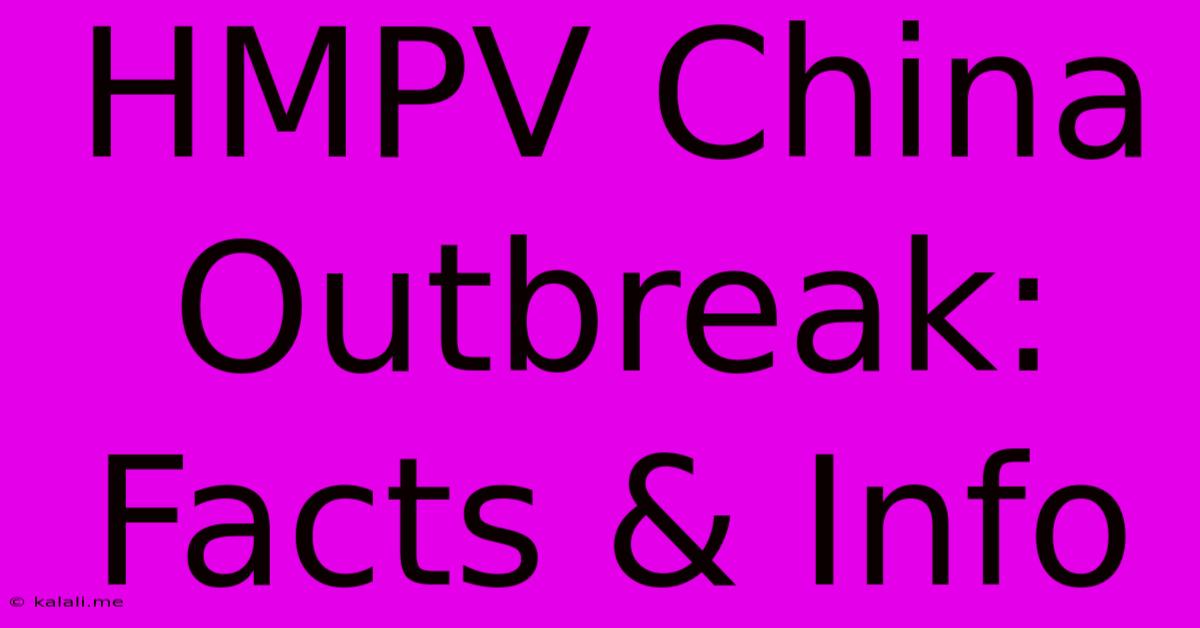HMPV China Outbreak: Facts & Info
Kalali
Jan 10, 2025 · 4 min read

Table of Contents
HMPV China Outbreak: Facts & Information
The recent surge in Human Metapneumovirus (HMPV) infections in China has raised concerns globally. While HMPV isn't a new virus, its increased prevalence and impact warrant a closer look at the facts and available information. This article provides a comprehensive overview of the situation, addressing key questions and concerns surrounding this respiratory virus outbreak.
Understanding Human Metapneumovirus (HMPV)
HMPV is a common respiratory virus belonging to the Paramyxoviridae family. It's closely related to other viruses like RSV (Respiratory Syncytial Virus) and measles. HMPV primarily affects the lungs and airways, causing illness ranging from mild cold-like symptoms to severe pneumonia, particularly in vulnerable populations.
Transmission & Symptoms
HMPV spreads through the air via respiratory droplets produced when an infected person coughs or sneezes. Close contact with an infected individual increases the risk of transmission. Symptoms typically appear 2-6 days after infection and can include:
- Fever
- Cough
- Runny nose
- Sore throat
- Headache
- Muscle aches
- Shortness of breath (in severe cases)
Infants, young children, the elderly, and individuals with pre-existing health conditions are at higher risk of developing severe HMPV infections. These groups may experience more severe symptoms and complications, requiring hospitalization.
The China Outbreak: Key Factors
The current situation in China highlights several important factors contributing to the increased number of HMPV cases. While precise data on the outbreak's magnitude is still emerging, several contributing elements are being discussed:
Weakened Immunity Post-COVID-19
The impact of the recent COVID-19 waves in China may have played a significant role. Reduced exposure to other respiratory viruses during strict COVID-19 measures might have led to a decrease in overall population immunity, creating a susceptible population more vulnerable to HMPV infection. This phenomenon, known as "immune debt," has been observed with other viruses following pandemic restrictions.
Seasonal Factors
HMPV infections, like many respiratory viruses, are often seasonal, with outbreaks typically occurring during the cooler months. The timing of the current outbreak in China aligns with the typical seasonal pattern, potentially contributing to its spread.
Increased Surveillance and Testing
It is crucial to note that the increased number of reported HMPV cases might also be due to improved surveillance and diagnostic testing capabilities. Increased testing and reporting could lead to a seemingly larger outbreak even if the actual infection rate hasn't dramatically increased. This highlights the importance of interpreting data cautiously and acknowledging potential reporting biases.
Impact on Healthcare Systems
The surge in HMPV cases has undoubtedly put a strain on China's healthcare system. Hospitals are experiencing increased patient admissions, particularly among vulnerable populations requiring intensive care. This underscores the need for robust healthcare infrastructure capable of handling outbreaks of respiratory infections. Efficient resource allocation, including medical personnel, beds, and ventilators, is crucial to effectively manage the situation.
Prevention and Treatment
There's currently no specific antiviral treatment for HMPV, but supportive care is vital. This includes:
- Rest: Adequate rest is essential for recovery.
- Hydration: Drinking plenty of fluids helps prevent dehydration.
- Over-the-counter medications: Pain relievers and fever reducers can alleviate symptoms.
- Monitoring: Close monitoring for worsening symptoms, especially in high-risk individuals, is crucial.
Prevention strategies focus on limiting the spread of the virus:
- Handwashing: Frequent handwashing with soap and water or using an alcohol-based hand sanitizer is critical.
- Respiratory hygiene: Covering coughs and sneezes with a tissue or elbow can help prevent the spread of respiratory droplets.
- Avoiding close contact: Minimizing contact with sick individuals can reduce the risk of infection.
- Vaccination (future possibilities): While no HMPV vaccine is currently available, research into potential vaccines is ongoing. The development of an effective vaccine would significantly improve prevention efforts.
Global Implications and Preparedness
The HMPV outbreak in China serves as a reminder of the ongoing threat posed by respiratory viruses. While HMPV infections are typically not as severe as some other respiratory pathogens, their impact on vulnerable populations and healthcare systems cannot be underestimated. This event highlights the importance of global surveillance, collaboration, and preparedness for managing outbreaks of infectious diseases.
Strengthening public health infrastructure globally, including robust surveillance systems, early warning mechanisms, and the capacity for rapid response, is crucial. International collaboration on research and development of vaccines and treatments for HMPV and other respiratory viruses is vital to improve global health security and protect vulnerable populations worldwide.
Conclusion: Ongoing Monitoring and Vigilance
The HMPV outbreak in China underscores the dynamic nature of infectious disease outbreaks and the need for continuous monitoring and vigilance. While the situation remains fluid, understanding the factors contributing to the increased prevalence of HMPV and implementing effective prevention strategies is key to mitigating its impact. Future research and global collaboration will be crucial in improving our ability to manage and prevent future outbreaks of HMPV and other respiratory viruses. Further information and updates should be sought from reputable sources such as the World Health Organization (WHO) and national public health authorities. Staying informed and adhering to recommended preventive measures are crucial steps in protecting yourself and your community.
Latest Posts
Latest Posts
-
What Is 453 605 Rounded To The Nearest Thousand
Jun 30, 2025
-
How Many Grams Is A Kilo Of Coke
Jun 30, 2025
-
How Many Tablespoons In A Packet Of Hidden Valley Ranch
Jun 30, 2025
-
How Many Bunnies Are There In The World
Jun 30, 2025
-
How Is A Watch And Ruler Similar
Jun 30, 2025
Related Post
Thank you for visiting our website which covers about HMPV China Outbreak: Facts & Info . We hope the information provided has been useful to you. Feel free to contact us if you have any questions or need further assistance. See you next time and don't miss to bookmark.